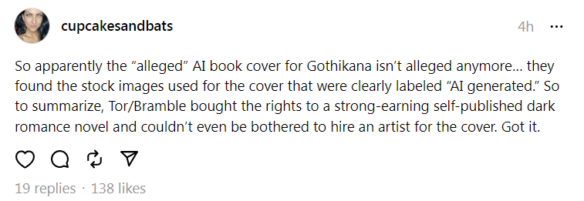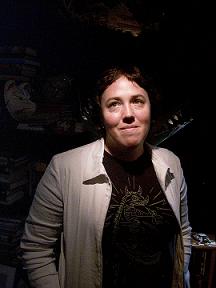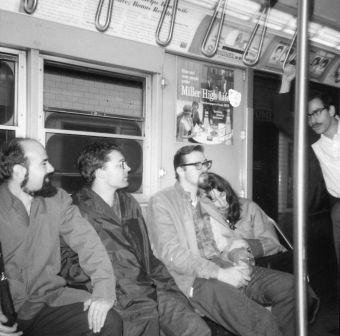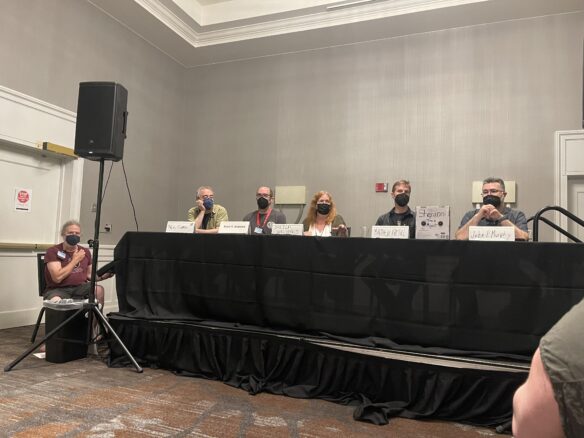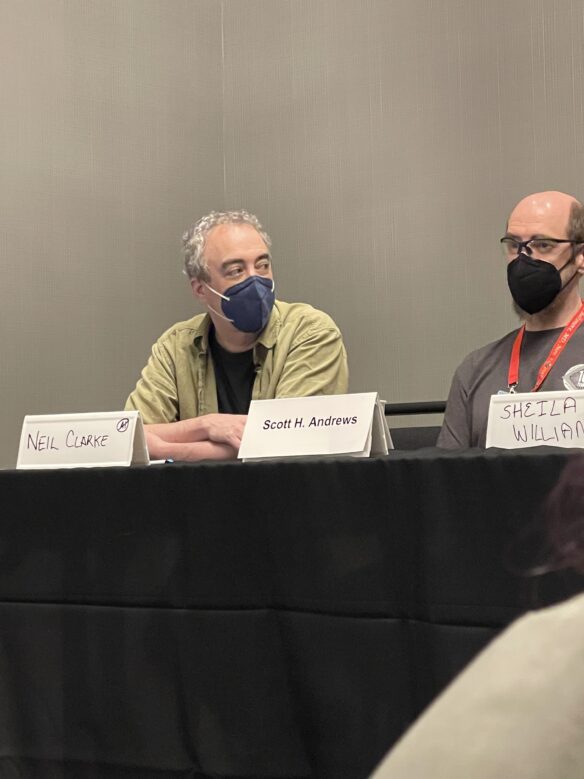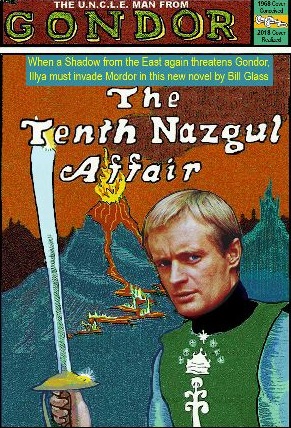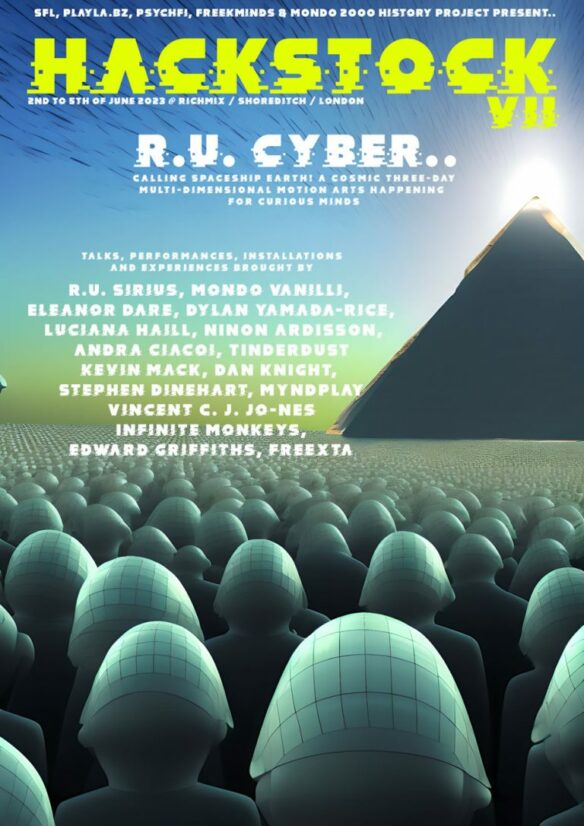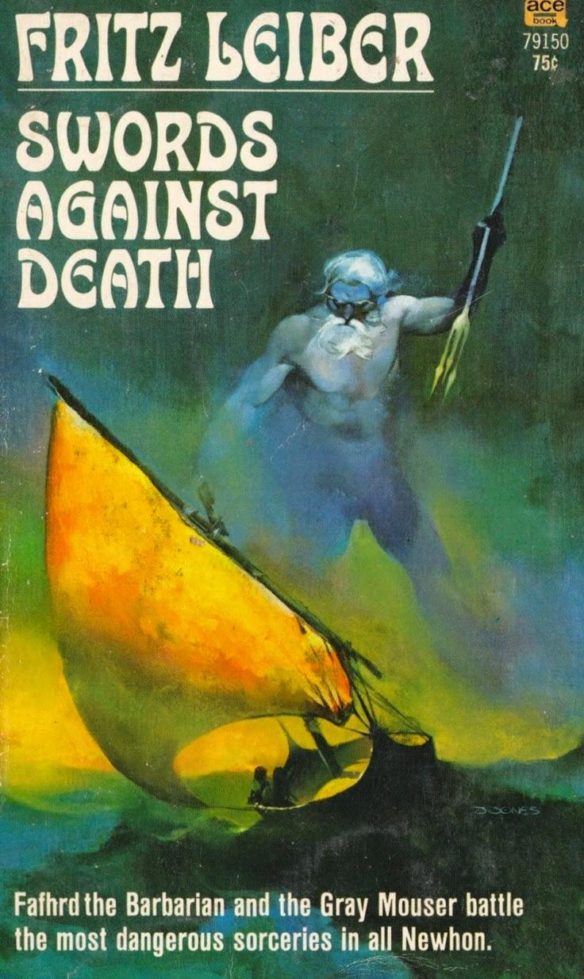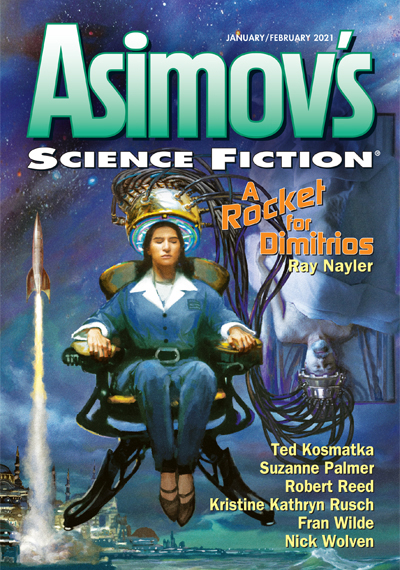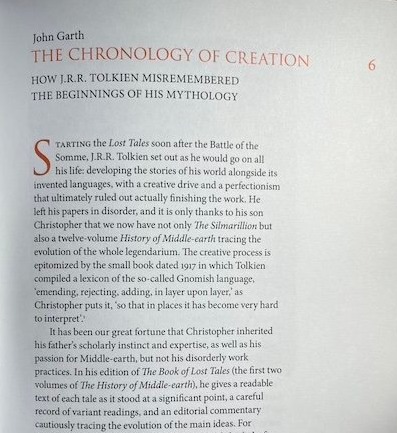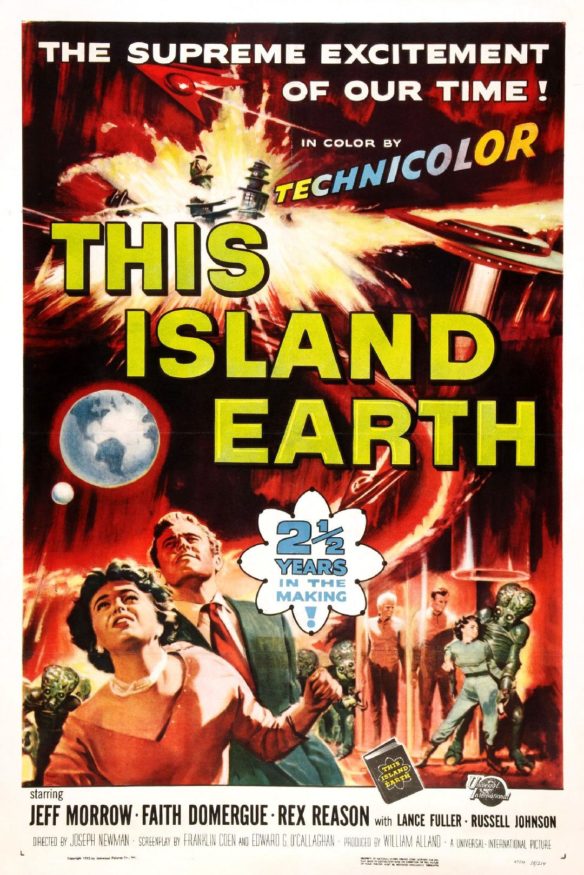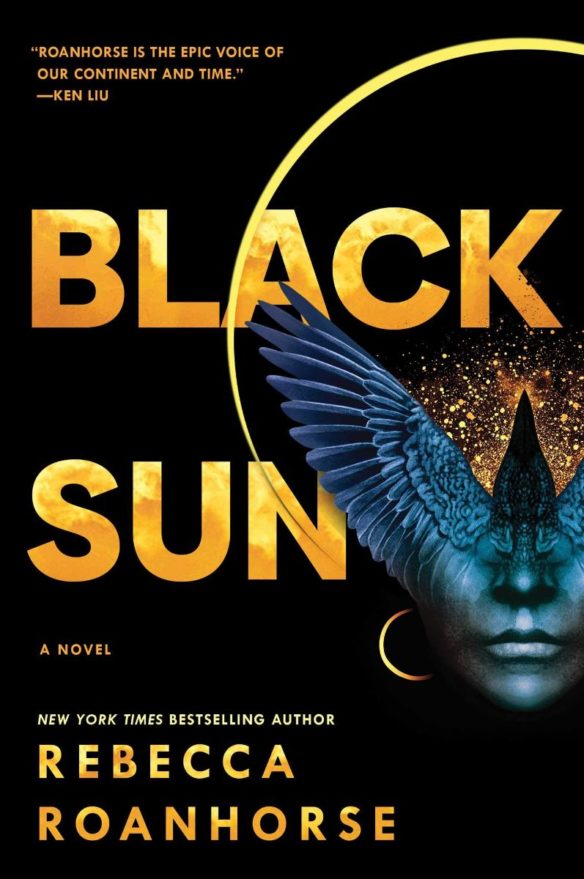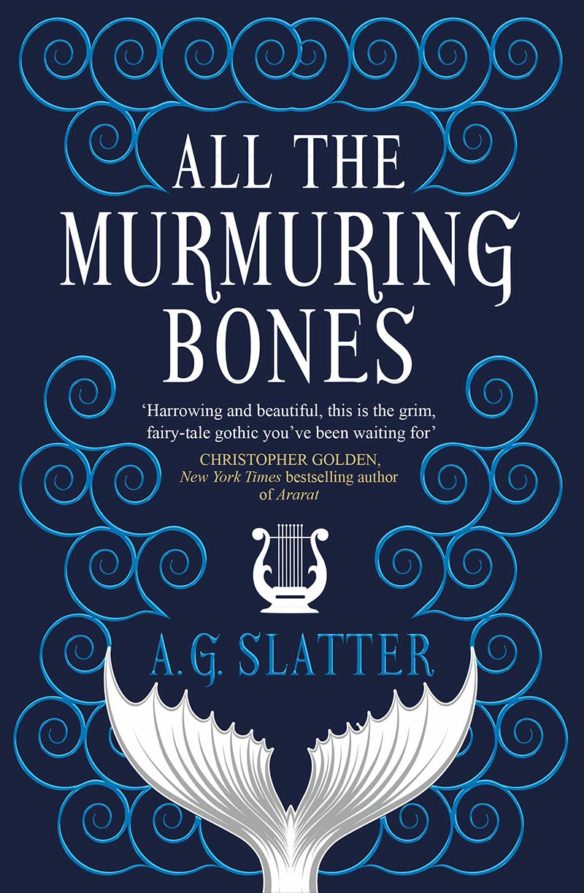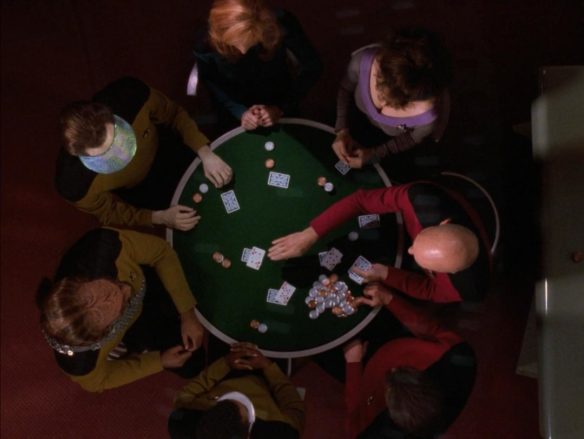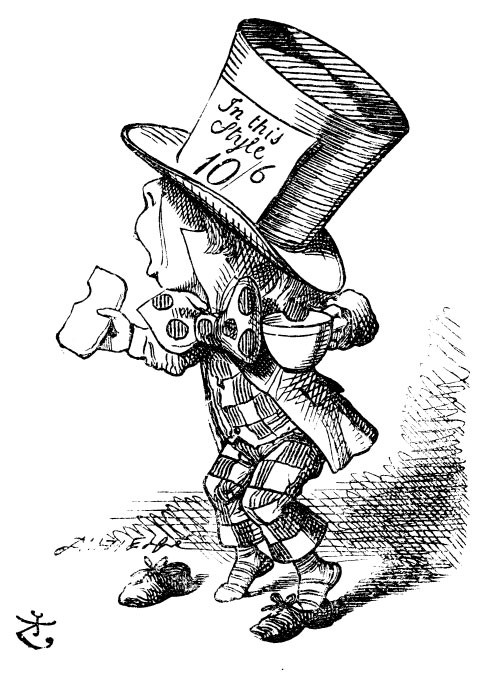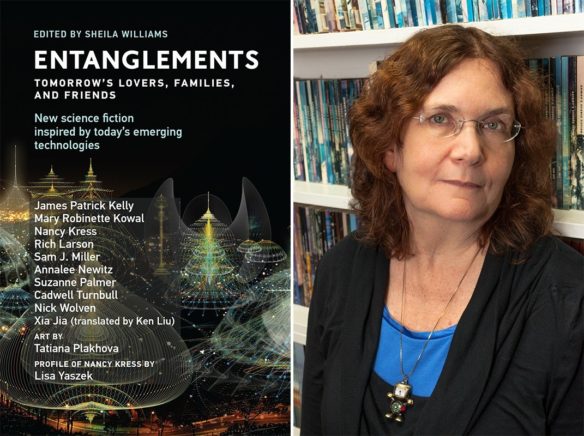(1) BOOK BANNING NEWS, [Item by Bruce D. Arthurs.] Malinda Lo’s Last Night At The Telegraph Club is one of a number of books being considered for a statewide ban in South Carolina. Lo wrote the review committee an excellent letter defending her book and others like it. “Telegraph Club Considered for Possible Statewide Ban in South Carolina”.
… The parent who challenged LNATTC and other books in Beaufort County and at the state level is Elizabeth Szalai. She had a 5% success rate in Beaufort County, but she has had a 100% success rate at the state level so far.
Szalai’s complaint claims that LNATTC “contains explicit sexual activities in violation of Regulation 43-170 specifically touching of breast and masterbation [sic].” The complaint includes excerpts of scenes from LNATTC stripped of their context. Indeed, the context of the entire novel is irrelevant to Regulation 43-170.
I am not optimistic that LNATTC will survive this challenge in South Carolina, but it’s still possible….
…I’ve written to South Carolina’s Instructional Materials Review Committee to support my book and to ask them to uphold our First Amendment rights. My letter is below:
Dear members of the Instructional Materials Review Committee of the South Carolina Department of Education:
My name is Malinda Lo, and I’m the author of several critically acclaimed and bestselling young adult novels, including Last Night at the Telegraph Club, which is currently under review by your committee. I’m writing to you not only as the author of this book, but as a concerned American citizen who believes strongly in our First Amendment.
Last Night at the Telegraph Club was the winner of the 2021 National Book Award for Young People’s Literature, the Stonewall Book Award, the Asian Pacific American Award for Literature, the Kids’ Choice Awards Teen Book of the Year, and over over two dozen more honors and awards. It is a coming-of-age novel about a Chinese American girl discovering her identity as a lesbian in 1950s San Francisco. I am a Chinese American lesbian myself, and when I was a teen growing up in the 1980s and ’90s, I often felt alone and confused. I didn’t have access to books like this that would have helped me to better understand who I was. That’s why I write books about LGBTQ+ and Asian American characters. I’m writing the books I needed as a teen.
Since Telegraph Club was published, many LGBTQ+ and Asian American readers have contacted me to tell me how much this book meant to them. Seeing yourself in a book can be a transformative and empowering experience. One reader wrote to tell me, “Your books helped me love and accept myself.” A Chinese American reader wrote, “I feel so seen. Perhaps a little bit too seen, as I am on the verge of tears.” A teen from Nashville told me, “it means a lot to see people like me in literature, written by people like me.”
I’m an immigrant who came to the United States with my family from China when I was a child, and we settled in Boulder, Colorado. I grew up knowing that we came here to escape the oppression of the Chinese Communist government, which does not allow freedom of expression or the freedom to read. This is why I’ve always valued our First Amendment rights. The possibility that my book could be banned across the entire state of South Carolina alarms me because censorship goes directly against the ideals of our country.
I urge you to trust the judgement of your local teachers and librarians, who selected my book — and many others — for their school libraries based on their professional judgement and training. While not every book is for every reader, every reader deserves the freedom to choose what they wish to read, not to have those rights taken away from them by the state. I hope you will take this opportunity to support our fundamental rights and freedoms as Americans.
Thank you for your consideration.
Sincerely,
Malinda Lo
The hearing is Thursday, March 13….
(2) GREG BEAR’S PAPERS TO SDSU. Astrid Bear updated readers of the late Greg Bear’s Facebook page:
My major task and accomplishment last year was sorting, boxing, and shipping Greg’s papers to his alma mater, San Diego State University, where they are held in the library’s Special Collections. There are 60+ boxes of journals, notes, manuscripts, and letters, plus a lot of his original artwork. It’s truly a treasure, a deep dive into his creative process and the breadth and depth of his thinking and interests. But here’s the thing about archived papers — for students and researchers to have meaningful access, there needs to be a catalogue of what’s there, called a finding aid, and the items need to be stored using archival standards, such as acid-free boxes. So, I’ve made a donation of $5,000 to help fund those efforts, and am asking you to help match that. A total of $10,000 will go a long way to make the archive accessible.
SDSU is having their major annual fundraising effort right now, so there’s a spiffy website interface for making donations. Link will be in the comments. If you are able to donate even a little bit, that will help meet the $10,000 goal. My match money is already there, just waiting to partner with yours.
“The link in the comments should take you my fundraising page. Scroll down to Matches and Challanges to find Library: $5K Match to the Special Collections Support Fund, and you’ll see my name there. Click on Contribute and it will take you to the page to enter your info. The designation should already be filled in, Library Special Collections Fund. If it’s not, go up a bit to the drop-down menu titled, “There are 6 matches and/or challenges running!” and select “Just for Library Special Collections Fund.”
“Thank you so much for considering this. SDSU and its libraries meant a lot to Greg, as did having his archives be available and studied long into the future.”
Here’s the link to the fundraiser: University Library · GiveCampus (sdsu.edu)
(3) PROZINE OWNERSHIP TRANSITION PLANS. Locus Online has extensive “Details on the New Owners of Analog, Asimov’s, and F&SF”, including statements from P.L. Stevens, publisher, of new owner Must Read Books Publishing, sellers Penny Publications and Gordon Van Gelder (F&SF), as well as Analog editor Trevor Quachri and Asimov’s editor Sheila Williams.
All editorial staff from the magazines have been retained in the acquisitions….
The parent company will take over sponsorship of the Astounding Award for Best New Writer, the Black Orchid Novella Award (with The Wolfe Pack), the Dell Award for Undergraduate Excellence in Science Fiction and Fantasy Writing, Asimov’s Readers Awards, AnLab Awards, The Analog Award for Emerging Black Authors, and Ellery Queen Readers Awards, among others.
(4) WHY YES, HOW DID YOU KNOW? Times have changed. People who’d had a few drinks and would want to avoid coming home smelling like the bar might chew a few Sen-Sen before they walked through the door. Today? To make sure they come home smelling that way – well, at least like they’ve had too much Butterbeer – Orly offers this line of Harry Potter-inspired cosmetics. “Ultimate Harry Potter™ Butterbeer™ Experience” at Orly Beauty.
Infused with the iconic BUTTERBEER™ scent from the Harry Potter™ film series, this collection features all four products from the BUTTERBEER™ collection. From a whimsical Iridescent Topper to a Quick Dry Nail Spray to Nourishing Cuticle Oil and Hydrating Cuticle Froth, your nail care routine is about to become your favorite experience.

(5) HALF-CENTURY OF ROCKY HORROR. “Strange Journey: The Story of Rocky Horror’ Review: Sweet Doc Tribute” at The Hollywood Reporter.
Watching Linus O’Brien’s Strange Journey: The Story of Rocky Horror, a new documentary launching out of SXSW, my most frequently thought was that — actual quality of the film notwithstanding — it’s an absolute blessing to be getting this examination of the Rocky Horror phenomenon at this particular moment in time.
Released tied to the 50th anniversary of the Rocky Horror Picture Show film, Strange Journey benefits to no small degree from the presence of O’Brien, son of The Rocky Horror Show creator Richard O’Brien — which means access to archives and memories and presumably easier facilitation of conversations with an astonishing assortment of people associated with the property at every level.
Richard O’Brien is 82; director Jim Sharman is 79; star Tim Curry is 78; Lou Adler, who brought the stage show from London to Los Angeles and then produced the movie, is 91. All are present in the documentary, as are musical director Richard Hartley, costumer Sue Blane, and stars including Susan Sarandon, Barry Bostwick, Patricia Quinn and even Peter Hinwood, who played Rocky and hasn’t acted since the ’70s. The time to get all of these people together, on camera, to discuss all things Rocky and share their stories is not infinite and, as a result, fans will find plenty to cherish in Strange Journey….
(6) COMICS ATTRACTING YOUNG READERS. [Item by Steven French.] This perhaps comes as no surprise to the parents among us: “’Something magical is happening’: sales boom for children’s comics creating young readers of the future” in the Guardian.
The best route to learning to love words in print could well be pictures. This, at least, is the hope of the publishing industry this spring, as it welcomes news that sales of children’s comics and graphic novels have reached an all-time peak of almost £20m in Britain.
While publishers and editors are celebrating this boom for its own sake, the popularity of these titles is also being hailed as a good omen for novels, ahead of the London Book Fair at Olympia this week. “Over the last decade we’ve seen a significant rise in sales of graphic novels for both the adult and children’s markets,” said Philip Stone, media analyst at NielsenIQ BookData, as he revealed details of the latest trends, hits and flops this weekend.
“Superhero books have been a reliably big feature, probably boosted by all the screen superhero movies. A lot of manga series are doing very well again, and this may also be linked to screen versions. What we really need now is some deep-dive research into the impact of graphic and comic fiction as a gateway for young people into reading. We certainly suspect it’s true.”…

(7) GENE WINFIELD (1927-2025). Custom car creator Gene Winfield died March 4 at the age of 97 reports Deadline.
Gene Winfield, a pioneering legend in the hot-rod world who created custom cars for numerous films and TV shows including Blade Runner, the original Star Trek series, RoboCop, Get Smart! and many others, has died. He was 97.
Winfield’s …. most famous creations include the iconic Galileo shuttlecraft and the Jupiter 8 for Star Trek [seen in the episode “Bread and Circuses”]…and the “spinners” for Blade Runner, which was nominated for the Special Effects Oscar. He also built the Catmobile for TV’s Batman and gadget cars for Get Smart! and The Man from U.N.C.L.E.
His futuristic vehicles are seen in Back to the Future II, the original RoboCop, The Last Starfighter, Woody Allen’s Sleeper and others. Winfield’s cars also are seen in the Dirty Harry sequel Magnum Force, Bewitched, Ironside, TV’s Mission: Impossible and more….
(8) MEMORY LANE.
[Written by Cat Eldridge.]
JDM Bibliophile zine
JDM Bibliophile (1965–2004). This one is for John D. Macdonald completists.
John D. MacDonald became the subject of a fan magazine in March 1965 when Len and June Moffatt of Downey, California first published the JDM Bibliophile (JDMB), devoted to his work. MacDonald starting writing for pulp magazines in 1946 during their waning days.
JDMB, a mimeographed magazine at the time, was described in its initial issue as a “non-profit amateur journal devoted to the readers of John D. MacDonald and related matters.” A goal was to obtain complete bibliographic information on all of MacDonald’s writings, and this was partly achieved with The JDM Master Checklist, published in 1969 by the Moffatts.
They had help from many people, including MacDonald himself. Though he kept good records, he, like most authors, didn’t have complete publishing data on his own work. Especially helpful to the Moffatts were William J. Clark and another couple, Walter and Jean Shine of Florida.
The Shines published an updated version of the Checklist in 1980, adding illustrations, a biographical sketch, and a listing of articles and reviews of MacDonald. JDMB offered news and reviews of MacDonald’s writings and their adaptation to various media. There were also contributions from MacDonald, including reminiscences and commentary. The Moffatts contributed a column (“& Everything”), as did the Shines (“The Shine Section”). Other JDM fans sent articles, letters, and parodies. One issue, #25 in 1979, included the Shines’ “Confidential Report, a Private Investigators’ File on Travis McGee,” describing information gleaned from the McGee canon about his past, interests, cases, and associates. MacDonald once said of Walter Shine, “He knows more about Travis than I do.”
After the Moffatts had published twenty-two issues of JDMB, it was transferred in 1979 to the University of South Florida in Tampa, with Professor Edgar Hirshberg as editor. It continued until 1999. One final issue, #65, was published as a memorial to Hirshberg who had died in June 2002. It was edited by Valerie Lawson. On February 21, 1987, about a hundred McGee fans gathered at his “address,” Slip F-18 at the Bahia Mar Marina in Fort Lauderdale, Florida, where McGee kept his houseboat The Busted Flush. The mayor of Fort Lauderdale unveiled a plaque honoring McGee.
Amazon has scattered back issues available.
So this cover for one of them done by an unknown USF student. If is not considered a close representation of The Busted Flush. For that, you should see the second image which is from The Busted Flush fan site as it “is a rendering of the boat, which MacDonald felt was very close to what he had in mind, but, as he always said about the boat and Travis McGee, he did not want to be exact about either. Let the reader fill in the gaps.”
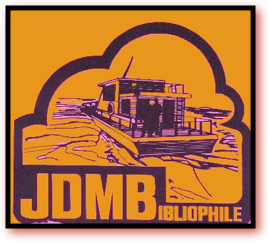

(9) COMICS SECTION.
- Barney and Clyde find it takes one to not know one.
- Carpe Diem predicts a future nostalgic view.
- Reality Check continues to have problems.
- The Argyle Sweater lists new reboots.
- Yaffle greets the offspring.
- Brewster Rockit is alarmed by a ransom note for an extra reason fans will appreciate.
- Saturday Morning Breakfast Cereal values a Master’s over a Ph.D.
(10) SHELVES OF DREAMS. “If You Build It, Comic Book Fans Will Come” contends Publishers Weekly.
Periodical comics made the leap from convenience store spinner racks to trade paperback collections at bookstore chains in the 1980s. And while the transition did present some initial challenges to booksellers—in those early days, it wasn’t uncommon to see superhero titles shelved next to Garfield in the “humor section”—the move proved both lucrative and permanent. Today, comics can be found wherever books are sold, with big-box retailers devoting considerable real estate to graphic novels. How do smaller specialty shops compete?
“Community is essential to the business,” says Jenn Haines, owner of The Dragon, an Eisner Spirit of Retailing Award–winning shop in Guelph, Ontario. “Generally, people who read comics have found themselves not quite fitting in.” But fans can find community, she adds, by browsing the shelves.
According to the latest ICv2 industry report, of the $1.87 billion in comics and graphic novel sales in 2023, 61% are from book channels, while 36% are via the direct market, which comprises approximately 3,000 specialty comics retailers. Indications are that specialty shops’ share rose in 2024, which was “a pretty good year in comic stores,” reports Milton Griepp, president of ICv2, which did not release full figures by press time.
According to Haines, her store’s annual sales have been generally consistent over the past five years. The Dragon’s overall 2024 sales, which includes games and toys, were up 3% over 2023, with sales of comics and graphic novels increasing 5%….
(11) UPSTAIRS, DOWNSTAIRS. Conor Dougherty analyzes “How ‘Silo’ and ‘Paradise’ Envision Housing After the Apocalypse” in the New York Times (behind a paywall).
“Paradise” is a TV show on Hulu about a postapocalyptic society that lives underground in a suburb. “Silo” is a TV show on Apple TV+ about a postapocalyptic society that lives underground in an apartment tower.
Both are propelled by mysteries. Both feature curious heroes. Both have shifty leaders who lie, blackmail and murder to keep their secrets hidden and their denizens in line.
The shows have much in common, in other words.
But somehow they find opposing answers to a question that seems increasingly relevant in a warming world: If the planet goes to hell and humanity heads to a bunker, what sort of neighborhood will we build inside it? A spacious holdout that tries to approximate a comfortable standard of living, or a cramped locker that saves more lives but leaves the survivors miserable?
By imagining wildly different landscapes in response to the same end-of-the-world conceit, the shows use cinematic extremes to show how civilization and class divisions are constructed through the apportionment of space. People like to live around other people right up to the moment they feel their neighborhood has been overrun by others, at which point the hunger for togetherness becomes an impulse to exclude.
A good amount of today’s housing politics fall within these parameters, whether it’s a proposal to build apartments in a suburb or a plan to cover farms with a new city. The fact that this debate now extends to fictional bunkers has me convinced that in the aftermath of global calamity, people will be at some dystopian City Council meeting arguing about zoning….
(12) WHEN BUSINESS IS BOOMING AND THAT’S NOT GOOD. [Item by Mark Roth-Whitworth.] I don’t want to just link to an X-twit post, so… Sounds like they should *not* have launched that last one, given this. My take is that Elon was hurting, the attacks by the public on him, and on Tesla, and he said “launch”. As reported on Slashdot: “Anonymous Sources: Starship Needs a Major Rebuild After Two Consecutive Failures”.
According to information at this tweet from anonymous sources, parts of Starship will likely require a major redesign due to the spacecraft’s break-up shortly after stage separation on its last two test flights. These are the key take-aways, most of which focus on the redesign of the first version of Starship (V1) to create the V2 that flew unsuccessfully on those flights…
(13) BUSY SKIES. “Saturn Gains 128 New Moons, Bringing Its Total to 274” – the New York Times is counting.
Astronomers say they have discovered more than 100 new moons around Saturn, possibly the result of cosmic smashups that left debris in the planet’s orbit as recently as 100 million years ago.
The gas giant planets of our solar system have many moons, which are defined as objects that orbit around planets or other bodies that are not stars. Jupiter has 95 known moons, Uranus 28, and Neptune 16. The 128 in the latest haul around Saturn bring its total to 274.
“It’s the largest batch of new moons,” said Mike Alexandersen at the Harvard-Smithsonian Center for Astrophysics, an author of a paper announcing the discovery that will be published in the days ahead in Research Notes of the American Astronomical Society.
Many of these moons are rocks only a few miles across — small compared with our moon, which is 2,159 miles across. But as long as they have trackable orbits around their parent body, the scientists who catalog objects in the solar system consider them to be moons. That is the responsibility of the International Astronomical Union, which ratified the 128 new moons of Saturn on Tuesday….
… The current naming scheme for moons on Saturn is based on characters from Norse and other mythology.
“Maybe at some point they’ll have to expand the naming scheme further,” Dr. Alexandersen said….
(14) LANDING IN THE FINAL FRONTIER. “Saucer-like ‘Winnebago’ space capsule lands in Australia — marking 1st for commercial space industry” reports Live Science.
A saucer-like space capsule touched down in the Australian outback last month, marking the first time a commercial spacecraft has landed Down Under.
Varda Space Industries’ Winnebago-2 (W-2) space capsule reentered Earth’s atmosphere and dropped down in South Australia on Feb. 28. In doing so, W-2 also set a world first by becoming the first commercial spacecraft to return to a commercial spaceport, according to a statement released by the Australian Space Agency.The successful return of W-2 was a “landmark moment for the Australian space sector,” Australian Space Agency representatives wrote in the statement.
The company behind W-2, Varda, is an American startup based in California. W-2 originally left Earth from California on a SpaceX Falcon 9 rocket on Jan. 14 as part of the Transporter-12 rideshare mission — the Transporter carries satellites from various customers into space. W-2 then spent 45 days in orbit, carrying payloads from the U.S. Air Force and NASA before dropping down to the Koonibba Test Range, run by Australian aerospace company Southern Launch….
(15) BEAST GAMES PITCH MEETING. [Item by Mike Kennedy.] Beast Games was apparently inspired in part by how much the host (famed YouTuber Mr. Beast) enjoys Squid Games. But there’s also apparently zero to very little about the actual games played on BGs that is inspired by games on SGs. Also, no killing the contestants. Not that I’ve ever watched either show (or anything by Mr. Beast), nor would I care to.
[Thanks to Andrew Porter, John King Tarpinian, Chris Barkley, Daniel Dern, Bruce D. Arthurs, Cat Eldridge, SF Concatenation’s Jonathan Cowie, Mark Roth-Whitworth, Steven French, Kathy Sullivan, Teddy Harvia, and Mike Kennedy for some of these stories. Title credit belongs to File 770 contributing editor of the day Daniel “Good, Bester, Best!” Dern.]

